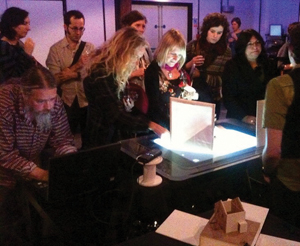Learning from experiments
Hasan Bakhshi argues that research and development in the arts plays an important role, just as it does in science or technology

The phrase ‘research and development’ (R&D) conjures up images of white-coated scientists in laboratories or inventors creating new gadgets. But science and technology are not the only areas where investment in innovation matters. R&D in the arts is far less well understood, but has huge potential to cultivate the arts and to elevate their place in society.
The arts are all about the new, about creative experimentation. R&D takes this a step further, involving purposeful testing of a new proposition or idea and making explicit the knowledge created so that others can learn from the experiment. This way, insights, techniques and approaches can be shared, helping the ‘field’ to develop.
The National Theatre’s ‘NT Live!’ pilots tested a series of propositions around audience engagement with live broadcasts, the findings of which were written up and widely disseminated. When Handspring Puppet Company developed the groundbreaking techniques that brought a puppet horse to life on the Olivier’s stage, the creative process was dissected and documented on film in Making War Horse. Watershed’s ‘Theatre Sandbox’ project involved theatre makers exploring the use of technology to create new forms of immersive and interactive experience, through knowledge exchange between the artists it supported; the lessons were codified and published.
UK businesses each year spend billions of pounds on ‘research and experimental development’, which the Organisation for Economic Cooperation and Development’s Frascati Manual – the R&D policymakers’ bible – defines as “creative work undertaken on a systematic basis in order to increase the stock of knowledge, including knowledge of man, culture and society, and the use of this stock of knowledge to devise new applications”. There is nothing inherent in the arts that excludes them from this definition. But in the absence of a rigorous understanding of R&D processes as they apply to the arts, it is no surprise that society restricts, for policy purposes, the definition of R&D to science. For example, the official guidelines on the R&D tax credit state that you can only claim if your ‘R&D project seeks to achieve an overall knowledge or capability in a field of science or technology… Science does not include work in the arts, humanities and social sciences.”
This has serious consequences. It means that established funding streams for R&D activity exclude the arts. In partnership with Arts Council England (ACE) and the Arts and Humanities Research Council (AHRC), the National Endowment for Science, Technology and the Arts (NESTA) is taking steps to address the imbalance through the Digital R&D Fund for Arts & Culture. The focus of this fund is to connect arts and cultural organisations with technology companies in a way that the wider sector can learn from. Specifically, we will be working with arts and cultural organisations to test propositions on how new technologies can be used to broaden, widen and deepen audience engagement and to explore new business models.
The fund itself is small relative to the kind seen in the sciences: £500,000 is being made available, split over a relatively small number of projects. However, we hope that the projects we support will have a big impact on the sector. Crucially, the fund is an opportunity to improve our understanding of arts R&D processes ahead of ACE’s planned £20m Digital Innovation and Development Programme which is due to be announced later this year.
In an ideal world, we would support a range of innovative projects through the fund, but to ensure we support the strongest projects we are deliberately not setting any quotas and will judge each application on its merits. At the heart of the fund is our belief that collaboration is key for R&D in the arts and cultural sector. We have asked all applicants to seek a technology partner with whom they can collaborate. As well as an opportunity for arts and cultural organisations, this is a great chance for firms offering technology services to better understand the opportunities and challenges of working in the arts and cultural sector.
We are also actively encouraging collaboration between organisations in the arts and cultural sector, with the aim that organisations which are more digitally advanced will work with those that are less experienced. And last but not least is a partnership with researchers. Working with the AHRC, we are teaming researchers up with each project we are supporting through the R&D fund.
The arts have a dynamic and complex relationship to society. They embed themselves in our lives in new and ever-changing ways. It is part of what makes the arts so vibrant. A more systematic and rigorous understanding of how this works can enhance the contribution that the arts make to our lives.
Join the Discussion
You must be logged in to post a comment.